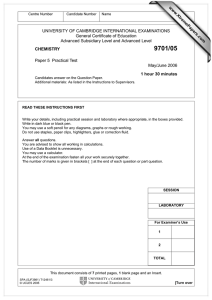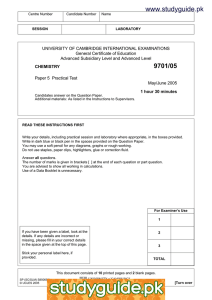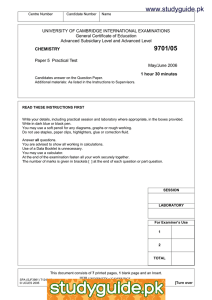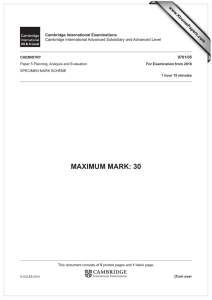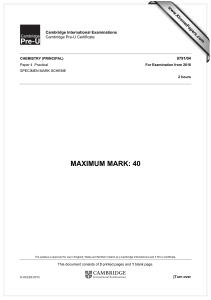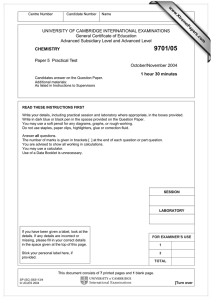UNIVERSITY OF CAMBRIDGE INTERNATIONAL EXAMINATIONS General Certificate of Education www.XtremePapers.com
advertisement
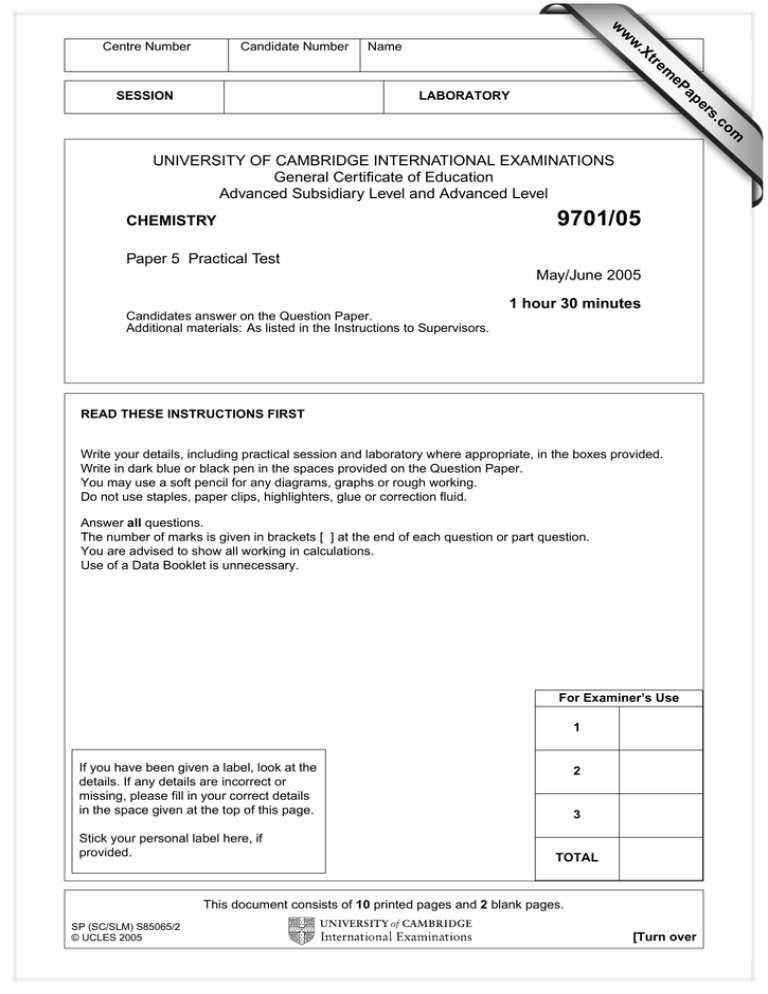
w w Name SESSION ap eP m e tr .X Candidate Number w Centre Number LABORATORY om .c s er UNIVERSITY OF CAMBRIDGE INTERNATIONAL EXAMINATIONS General Certificate of Education Advanced Subsidiary Level and Advanced Level CHEMISTRY 9701/05 Paper 5 Practical Test May/June 2005 1 hour 30 minutes Candidates answer on the Question Paper. Additional materials: As listed in the Instructions to Supervisors. READ THESE INSTRUCTIONS FIRST Write your details, including practical session and laboratory where appropriate, in the boxes provided. Write in dark blue or black pen in the spaces provided on the Question Paper. You may use a soft pencil for any diagrams, graphs or rough working. Do not use staples, paper clips, highlighters, glue or correction fluid. Answer all questions. The number of marks is given in brackets [ ] at the end of each question or part question. You are advised to show all working in calculations. Use of a Data Booklet is unnecessary. For Examiner’s Use 1 If you have been given a label, look at the details. If any details are incorrect or missing, please fill in your correct details in the space given at the top of this page. Stick your personal label here, if provided. 2 3 TOTAL This document consists of 10 printed pages and 2 blank pages. SP (SC/SLM) S85065/2 © UCLES 2005 [Turn over For Examiner’s Use 2 1 FB 1 is 2.00 mol dm–3 hydrochloric acid, HCl. FB 2 is a solid carbonate, X2CO3 in a stoppered tube. FB 2 reacts with hydrochloric acid as shown in the equation below. X2CO3(s) + 2HCl aq) → 2XCl (aq) + H2O(l) + CO2(g) You are to determine the mass of carbon dioxide evolved in the reaction of the carbonate FB2 with excess hydrochloric acid and to calculate from the results of the experiment the relative atomic mass, Ar, of X. (a) Use a measuring cylinder to place 100 cm3 of FB 1 into a 250 cm3 conical flask. Weigh the flask and acid. Record the mass in Table 1.2. Weigh the stoppered tube containing FB 2. Record the mass in Table 1.1. Add the weighed FB 2, a little at a time with swirling, to the acid in the conical flask. N.B. Take care to avoid excessive bubbling and loss of acid as ‘spray’. When all of the FB 2 has been added from the tube, reweigh the empty tube (with its stopper) and record the mass in Table 1.1. Leave the flask to stand for 2-3 minutes and then reweigh the flask and solution. Record the mass in Table 1.2. mass of stoppered tube + FB 2 /g mass of empty tube + stopper /g Table 1.1 mass of flask + acid /g mass of flask + solution after the reaction /g Table 1.2 [3] (b) Calculate the mass of FB 2 used. ………………… g [1] (c) Calculate the mass of carbon dioxide evolved. ………………… g [1] © UCLES 2005 9701/05/M/J/05 3 (d) Use your answer to (c) and the equation for the reaction to calculate the number of moles of X2CO3 that reacted. [Ar: C, 12.0; O, 16.0.] For Examiner’s Use ………………… moles [1] (e) Calculate the relative molecular mass, Mr, of X2CO3. Mr = ………………… [1] (f) Calculate the relative atomic mass, Ar, of X. [Ar: C, 12.0; O, 16.0.] Ar = ………………… [1] [Total : 8] © UCLES 2005 9701/05/M/J/05 [Turn over For Examiner’s Use 4 2 FB 3 is 1.50 mol dm–3 sodium hydroxide, NaOH. FB 4 is an aqueous solution containing hydrochloric acid. FB 4 has been prepared by dissolving 42.40 g of the carbonate FB 2 in an excess of 3.00 mol dm–3 hydrochloric acid and making the solution up to 1 dm3 in a graduated flask by adding more 3.00 mol dm-3 hydrochloric acid. You are to perform a thermometric titration to determine the end-point for the reaction of FB 3 and FB 4. In a thermometric titration the end-point is when the maximum temperature change occurs. (a) Fill the burette with FB 4. Support the plastic cup in a 250 cm3 beaker and pipette into the cup 50.0 cm3 of FB 3. Record the steady temperature of FB 3 in Table 2.1. Read through the following instructions before starting the experiment. Run 3.00 cm3 of FB 4 from the burette into the cup, stir the solution with the thermometer and record the new steady temperature. Without delay run a further 3.00 cm3 of FB 4 from the burette, stir and record the steady temperature as before. Continue the addition of FB 4 in 3.00 cm3 portions, taking and recording the steady temperature each time, until 48.00 cm3 of solution FB 4 have been run from the burette. Record all temperatures in Table 2.1. The thermometer provided has a range from ………….. oC to ………….. oC and has graduations at each …………… oC. volume of FB 4 added /cm3 0 temperature / °C t (temperature – initial temperature) / °C volume of FB 4 added /cm3 0 27.00 3.00 30.00 6.00 33.00 9.00 36.00 12.00 39.00 15.00 42.00 18.00 45.00 21.00 temperature / °C t (temperature – initial temperature) / °C 48.00 24.00 Table 2.1 © UCLES 2005 9701/05/M/J/05 [5] 5 (b) Plot a graph of t against the volume of FB 4 added. Draw two smooth curves through the plotted points to find the end-point for the titration. [3] © UCLES 2005 9701/05/M/J/05 For Examiner’s Use [Turn over 6 (c) Read from the graph the volume of hydrochloric acid, FB4, at the end-point of the titration. ……………………………….. cm3 [1] (d) Use your answer to (c) and the equation for the reaction to calculate the concentration of the hydrochloric acid in FB 4. NaOH(aq) + HCl (aq) → NaCl (aq) + H2O(l) .…………… [1] (e) The solution FB 4 was prepared by dissolving 42.40 g of X2CO3 in 1 dm3 of 3.0 mol dm-3 HCl . Use this information and your answer to (d) to calculate the number of moles of HCl that reacted with the dissolved X2CO3. .…………… [1] (f) . Calculate the relative molecular mass, Mr, of X2CO3. Calculate the relative atomic mass, Ar, of X. [Ar: C, 12.0; O, 16.0.] Ar = ………………… [1] [Total : 12] © UCLES 2005 9701/05/M/J/05 For Examiner’s Use For Examiner’s Use 7 3 ANALYSIS AND EVALUATION (a) Indicate the size of the error you would expect in making measurements with the thermometer in question 2. .......................................................................................................................................... .......................................................................................................................................... ......................................................................................................................................[1] (b) Why is it not necessary to consider the errors in the measuring cylinder used in question 1? .......................................................................................................................................... .......................................................................................................................................... ......................................................................................................................................[1] © UCLES 2005 9701/05/M/J/05 [Turn over 8 ASSESSMENT OF PLANNING SKILLS The relative atomic mass of X can also be determined by an experiment in which carbon dioxide is evolved in the reaction between a weighed sample of the carbonate of X and excess hydrochloric acid. The sample is added to the acid and the bung quickly re-inserted in the flask. The gas displaced from the apparatus is collected and its volume measured using the apparatus below. The acid is placed in a 250 cm3 conical flask and the gas collected by displacing water from an inverted 100 cm3 measuring cylinder. (c) In both Question 1 and the experiment above, the accuracy of the measured mass or volume can be improved by dissolving a small quantity of sodium carbonate in the acid before the start of the experiment. Suggest the reason behind this. .......................................................................................................................................... .......................................................................................................................................... .......................................................................................................................................... .......................................................................................................................................... .......................................................................................................................................... ......................................................................................................................................[2] © UCLES 2005 9701/05/M/J/05 For Examiner’s Use 9 (d) For the experiment shown in the photograph, suggest two other major sources of error (not including that mentioned in part (c)) in the spaces provided on page 10. For Examiner’s Use For each source of error describe a method of reducing this error, explaining the reasoning for your method. The data below may be relevant. Data Solubility of carbon dioxide gas at different temperatures temperature / oC solubility /g CO2 per 100 g of water 0 0.348 25 0.145 40 0.097 60 0.058 The general gas equation pV = nRT The specific heat capacity of water = 4.18 J g-1 K-1 Vapour pressure of water at different temperatures temperature / oC Vapour pressure /Pa 20 2388 25 3167 30 4243 35 5623 40 7376 Technical data for X2CO3 Minimum assay Substances insoluble in water Water Arsenic Lead Sulphate Iron © UCLES 2005 99% 0.0025% 0.35% 0.0001% 0.003% 0.02% 0.001% 9701/05/M/J/05 [Turn over For Examiner’s Use 10 (i) first major source of error ................................................................................................................................... method for reducing this error ................................................................................................................................... ................................................................................................................................... explanation ................................................................................................................................... ...............................................................................................................................[3] (ii) second major source of error ................................................................................................................................... ................................................................................................................................... method for reducing this error ................................................................................................................................... ................................................................................................................................... explanation ................................................................................................................................... ...............................................................................................................................[3] [Total : 10] © UCLES 2005 9701/05/M/J/05 11 BLANK PAGE © UCLES 2005 9701/05/M/J/05 12 BLANK PAGE Permission to reproduce items where third-party owned material protected by copyright is included has been sought and cleared where possible. Every reasonable effort has been made by the publisher (UCLES) to trace copyright holders, but if any items requiring clearance have unwittingly been included, the publisher will be pleased to make amends at the earliest possible opportunity. University of Cambridge International Examinations is part of the University of Cambridge Local Examinations Syndicate (UCLES), which is itself a department of the University of Cambridge. © UCLES 2005 9701/05/M/J/05



